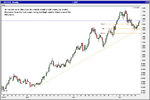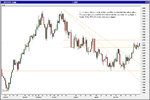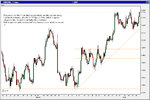Factors Affecting EUR/USD
The Eurozone: The 12 countries that have adopted the euro in order of GDP: Germany, France, Italy, Spain, Netherlands, Belgium, Austria, Finland, Portugal, Ireland, Luxembourg and Greece.
European Central Bank: Controls monetary policy for the eurozone. The decision making body is the Governing Council, which consists of the Executive Board and the governors of the national central banks. The Executive Board consists of the ECB President, Vice-President, and four other members:
ECB President, Wim Duisenberg (Netherlands)
Vice President, Christian Noyer (France)
Board Member (Chief Economist), Otmar Issing (Germany)
Board Member, Tomasso Padoa-Schioppa (Italy)
Board Member, Eugenio Domingo Solans (Spain)
Board Member, Sirkka Hamalainen (Finland)
Selected National Central Bank Governors:
Germany: Ernst Welteke
France: Jean-Claude Trichet
Italy: Antonio Fazio
ECB Policy Targets: The ECB has a primary objective of price stability. It has two main "pillars" of monetary policy. The first one is the outlook for price developments and risks to price stability. Price stability is defined as an increase of the Harmonized Index of Consumer Prices (HICP) of below 2%. While the HICP is very important, a broad number of indicators and forecasts are used to determine the medium term threat to price stability. The second pillar is monetary growth as measured by M3. The ECB has a "reference value" of 4.5% annual growth for M3.
The ECB holds a Council meeting every other Thursday to make announcements on interest rates. At each first meeting of the month, the ECB holds a press conference in which it gives its outlook on monetary policy and the economy as a whole.
Interest Rates: The ECB’s refinancing rate is the Bank’s key short-term interest rate used for managing liquidity. The difference between the refinancing rate and the US Fed Funds rate is a good indicator for the EUR/USD.
3-month Eurodeposit (Euribor): The interest rate on 3-month Euribor, deposits held in banks outside the Eurozone. It serves as a valuable benchmark for determining interest rate differentials to help estimate exchange rates. Using a theoretical example on EUR/USD, the greater the interest rate differential in favor of the euribor against the eurodollar deposit, the more likely EUR/USD is to rise. Sometimes, this relation does not hold due to the confluence of other factors.
10-Year Government Bonds: Another important driver of the EUR/$ exchange rate is the difference in interest rates between the US and Eurozone. The German 10-year Bund is normally used as the benchmark. Since the rate on the 10-year Bund is below that of the US 10-year note, a narrowing of the spread (i.e. rise in Germany yields or fall in US yields or both) is theoretically expected to favor the EUR/$ rate. A widening in the spread, will act against the exchange rate. So the 10-year US-German spread is a good number to be aware of. The trend in this number is usually more important than the absolute value. The interest rate differential, of course, is usually related to the growth outlook of the US and eurozone, which is another fundamental driver of the exchange rate.
Finance Ministers:
Germany: Hans Eichel, who took over when his more left-wing predecessor, Oskar Lafontaine, resigned in March 1999.
France: Christian Sautter replaced Dominique Strauss-Khan who resigned in November 1999.
Italy: Finance Minister Vicenzo Visco, Treasury and Budget Minister Giuliano Amato.
Economic Data: The most important economic data is from Germany, the largest economy, and from the euro-wide statistics, still in their infancy. The key data are usually GDP, inflation (CPI and HICP), Industrial Production, and Unemployment. From Germany in particular, a key piece of data is the IFO survey, which is a widely watched indicator of business confidence. Also important are the budget deficits of the individual countries, which according to the Stability and Growth Pact, must be kept below 3% of GDP. Countries also have targets for reducing their deficits further, and failure to meet these targets will likely be detrimental to the euro (as we saw with Italy’s loosening of its budget deficit guidelines).
Cross Rate Effect: The EUR/$ exchange rate is sometimes impacted by movements in cross exchange rates (non-dollar exchange rates) such as EUR/JPY or EUR/JPY. To illustrate: EUR/USD could fall as a result of significantly positive news in Japan, that filters through a falling EUR/JPY rate. Even though, $/JPY may be declining, euro weakness spills onto a falling EURUSD.
3-month Euro Futures Contract (Euribor): The contract reflects markets expectations on 3-month euro-Euro deposits (euribor) into the future. The difference between futures contracts on the 3-month cash eurodollar and on the euro-Euro deposit is an essential variable in determining EUR/USD expectations.
Other Indicators: There is a strong negative correlation between EUR/USD and USD/CHF, reflecting a steadily similar relation between the euro and the Swiss franc. This is because the Swiss economy is largely dependent upon the Eurozone economies. In most cases, a spike (dip) in EUR/USD is accompanied by a dip (spike) in EUR/CHF. The inverse also usually holds. This relationship sometimes fails to hold in the event of data or factors pertaining solely to either of the currencies.
Political Factors: As with all exchange rates, EUR/USD is susceptible to political instability such as a threat to coalition governments in France, Germany or Italy. Political or financial instability in Russia is also a red flag for EUR/USD, because of the substantial amount of Germany investment directed to Russia.



